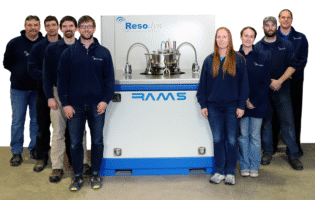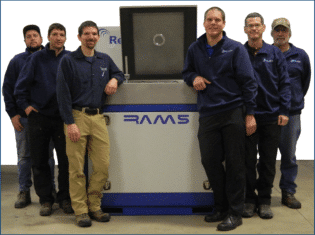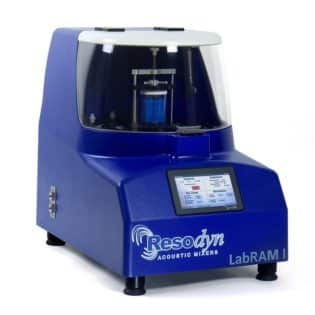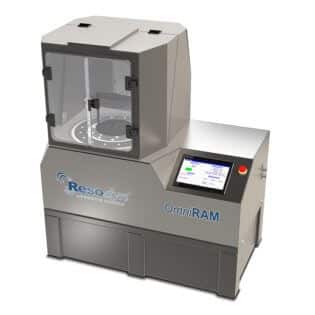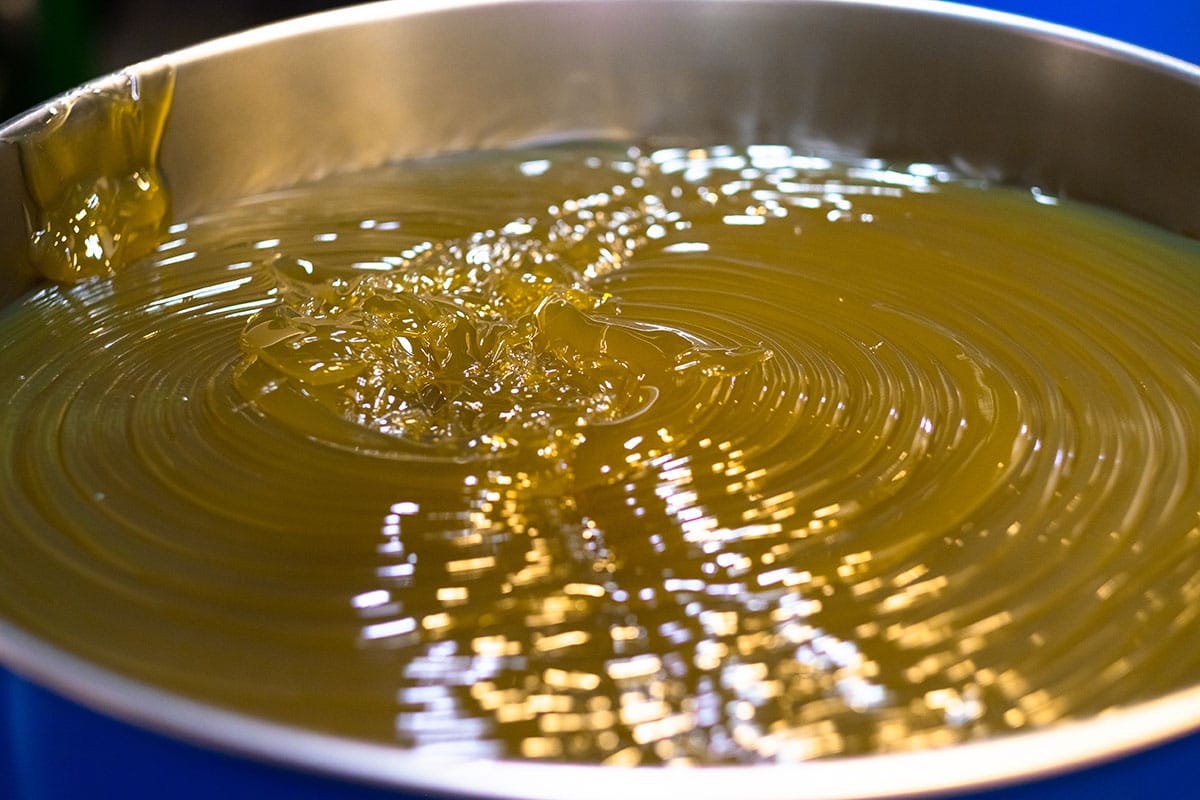
New High Viscosity Mixer Mixes Materials 10x to 100x Faster with Unmatched Uniformity Using Sound Energy
High viscosity mixers that work fast and mix evenly are a rare thing to find. After all, homogeneity of the final blend is a critical aspect of mixing as uniformity impacts the final product in many ways such as stability and durability. Viscosity is one of the properties that influences how easily a mixture can achieve homogeneity.
Viscosity is a measure of how resistant a fluid is to flow and is measured in centipoise (cP).
Low viscosity materials - such as water, have a lower resistance and flow more rapidly. Water has a viscosity of 1 cP.
High viscosity materials - such as honey or tar, resist deformation and flow more slowly. honey has a viscosity ranging from 2,000 to 10,000 cP. Some highly viscous materials have a viscosity of hundreds of millions centipoise.
Turbulent Flow
When it comes to mixing, turbulent flow is desired within the mixing vessel to create ideal mixing conditions. Turbulent flow is directly dependent on the fluid viscosity: the higher the viscosity, the more challenging it is to achieve turbulent flow.
For this reason, high viscosity materials are some of the most difficult ingredients for high viscosity mixers to blend effectively. They present unique challenges during mixing, particularly byproducts of high shear such as heat and material damage, higher power consumption, and high viscosity equipment wear and tear.
Principles and Equipment for Mixing High Viscosity Materials and Ingredients
These principles should be considered when working with highly viscous ingredients:
High Shear
When high viscosity fluids are mixed, stress and friction are created among the particles as they move. These are called shear forces and can result in damage to individual particles. Particle structures may be torn, broken, or severed and the overall particle size in the mix may decrease.
Shear is exacerbated by the movement of any agitator through the materials. In general, the more rapidly the blade moves through the vessel, the more shear. Many manufacturers have to slow down the mixing cycle to avoid high shear stresses and preserve particle integrity (and protect equipment) – resulting in longer mixing cycle times.
Energy Consumption and Heat Generation
It is no surprise that more energy is required to mix viscous ingredients that tend to be thick and heavy. Unfortunately, the viscosity sometimes reaches a point where the mixing motor starts to overload. Larger horsepower motors may be used in these cases but the energy efficiency declines significantly, driving up operating costs.
Additionally, the large amount of energy created by the impeller does not dissipate well in viscous materials and can result in heat build-up. To manage this issue, some companies utilize additional heat exchange equipment and temperature controls.
Cycle Times
As previously noted, it is challenging to achieve uniformity with highly viscous materials. Due to their resistance to flow, viscous mixes are at risk of localized mixing near and around the impeller, causing “dead spots” within the tank where minimal mixing occurs. This is a big problem for some manufacturers, specifically within the pharmaceutical industry, that relies on uniform dispersion of the Active Pharmaceutical Ingredients (API) throughout the product.
To achieve the requisite homogeneity, some manufacturers add viscous ingredients more slowly or stop the mixing operation to manually mix the material within the tank– both of which significantly lengthen cycle times and risk low quality results.
Scalability
Scale-up from the lab to production is more difficult with high viscosity liquid materials. These mixers endure a great deal of mechanical stress during operation, and must be engineered to withstand these forces. Manufacturers must ensure the drive components and agitators are properly designed to ensure safe and continuous operations. This additional engineering effort exacerbates upfront development costs and time to the mixer selection and fabrication process, increasing costs for users.
Viscosity Profile
It is important to understand the viscosity profile, specifically the maximum, as viscosity may change during the mixing cycle. If viscosity increases over time, the mixing equipment must be designed to manage any such viscosity change.
Cleanup
Often overlooked as mere overhead, the labor, materials, transportation, and disposal costs are not insignificant, particularly if the mixing system used produces high rates of wasted batches, For which all the clean-up materials and products must also be considered waste.
How RAM Solves High Viscosity Mixing Equipment Challenges
ResonantAcoustic® Mixing (RAM) is a game-changer for high viscosity mixing. Pastes and viscous mixes are made up of solids in a liquid matrix. Less liquid in the matrix produces higher viscosity, into the hundreds of millions of centipoise – approaching what appears to be and behaves much like a solid.
RAM mixes highly viscous materials at levels no traditional mechanical mixer can. Using sound energy, RAM's high viscosity mixers deliver wetting, incorporation, and widespread mixing rapidly and uniformly throughout the matrix.
RAM high viscosity mixers accelerate these processes by creating a phenomenon known as Faraday instabilities. The surfaces of ingredient liquids become unstable, causing “fingers” and “cavities” to form at the liquid surface boundary or interface. This swiftly increases the surface area of the liquids and facilitates rapid and homogenous mixing of the ingredients. Click here to watch a video demonstrating the Faraday instabilities created within RAM mixers.
To solve the challenges noted above with high viscosity materials, manufacturers often employ additional measures to achieve the desired mixing. For example, some companies use multiple mixing tanks – one tank with a high-shear mixer and a second tank with a lower-shear agitator to reduce particle damage and manage power consumption and heat generation for viscous mixes.
These additional steps and equipment lengthen cycle times, complicate equipment cleaning, and increase capital and operating costs. These measures are not necessary with RAM. Below are examples of how the RAM technology effectively mixes high viscosity materials.
Overcome Mechanical Restrictions
Traditional, blade and axis technologies can work through early stages of wetting and possibly incorporation, but often overheat or grind to a halt when mixing starts and the viscosity increases. Every highly viscous mixing process requires wetting, incorporation, and mixing phases. Without the mechanical limitations of axis/blade methods that require all materials to pass through a limited mixing zone, RAM technology performs all three steps comprehensively and consistently everywhere in the mixing vessel, reducing processing time by orders of magnitude, even overcoming mixing challenges considered to be impossible.
Low Shear Mixing Regardless of Viscosity
RAM technology is a “non-contact” mixing method requiring no blades, propellers, or other engineered devices to cause mixing. This also means that the high shear traditionally associated with high viscosity materials can be eliminated, allowing delicate or hazardous materials to be processed rapidly without excessive heat build-up or physical shear stress.
Achieve High Viscosity Mix Quality
The more viscous a material, the more difficult it is to mix traditionally. This means that consistent dispersion and distribution suffer at higher centipoise. These restrictive phenomena are completely avoided using RAM mixers at any scale. Sound energy wets, incorporates, and mixes materials rapidly, thoroughly at levels of quality not previously possible. Over years of test data across numerous industrial installations, RAM devices have delivered exceptional results, well into the tens of millions of centipoise.
High Viscosity Mixing and Processing Accessories
Every RAM device’s mixing parameter variables can be enhanced by combinations of vacuum, mixing payload temperature control, and other accessories. Viscous materials often mix more effectively at higher temperatures and under vacuum. RAM systems provide these functions before, during, and after actual mixing operations. This means that idle, degassing time, and failed batches due to the wrong temperature are eliminated.
Resodyn's High Viscosity Mixers Are Used Worldwide by National Labs and Fortune 100 Companies
From the world's top pharmaceutical companies to international manufacturers, global tech giants, and nearly every U.S. National Laboratory, organizations in more than 40 countries rely on Resodyn ResonantAcoustic® Mixers’ single, powerful technology platform. Whether used for development of new materials in a laboratory or for running full-scale industrial production, RAM systems are available in configurations to fit applications across dozens of industries.
Resodyn is the only company in the world to offer RAM technology. Change the way you think about mixing and processing with a RAM demonstration: on-site at your facility via live-web video tools, using your own materials, and solving your specific mixing challenges.
Need help with a challenging mix? Contact us today to learn how RAM can benefit your mixing operations or to schedule a free demo!











